|
On Saturday 28th November 1998, Andy Guthrie and
I observed what we believe is a Cave Swallow (Petrochelidon
fulva) hawking over the golf course at Riis Park, Queens, New
York. Here are a collection of photographs of this bird. We later
saw two Cave Swallows (presumably the initial bird plus a second)
circling over the nearby Fort Tilden Headquarters. These constitute
the 2nd and 3rd records for New York State (pending acceptance).
Click here for some additional pictures.
Click here for a description of the
sighting.
Finally click
here for a collection of comments on the photos and discussion
of subspecific identification and ageing by subscribers to ID-Frontiers.
All images copyright © of Angus Wilson.
|
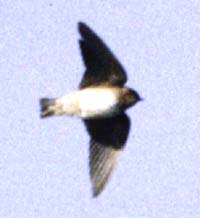 
Figure 1. The
breast, belly, flanks and vent region are white. The upper
breast and throat are cinnamon (color slightly obscured by
shadow). Notice the slight notch in the tail.
|
|
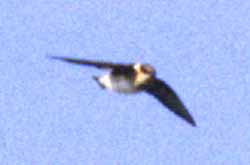  Figure
2. Side on view
showing the pale cinnamon of the throat extending across
lower nape as a collar. In the field the forehead color
was difficult to determine (through 30x scope) but seemed
dark (possibly red). In these photos the forehead appears
lighter than the dark blue cap with a clear hint of red
(especially close to the bill). The forehead is clearly
darker than the throat. Figure
2. Side on view
showing the pale cinnamon of the throat extending across
lower nape as a collar. In the field the forehead color
was difficult to determine (through 30x scope) but seemed
dark (possibly red). In these photos the forehead appears
lighter than the dark blue cap with a clear hint of red
(especially close to the bill). The forehead is clearly
darker than the throat.
|
|
 
Figure 3. The
mantle and crown are a dark metallic blue. The forehead
shows a tint of red above the bill and mask.
|
|
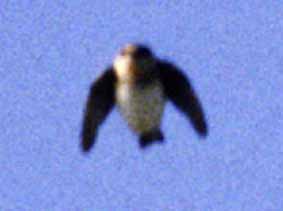 
Figure 4. Head-on
view showing the pale cinnamon throat. Note the contrast
with the white belly, flanks and vent.
|
|
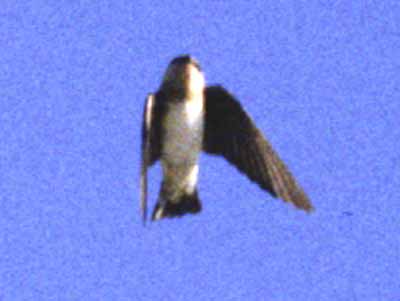 
Figure 5. In life, the
throat was pale cinnamon without any signs of a dark patch.
The dark areas in these photos are shadows. Note the dark
areas on some of the undertail coverts.
|
|
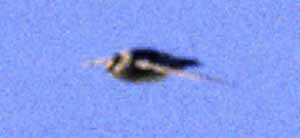 
Figure 6.
Side-profile showing cinnamon of the throat extending up
across the nape as a prominent collar.
|
|
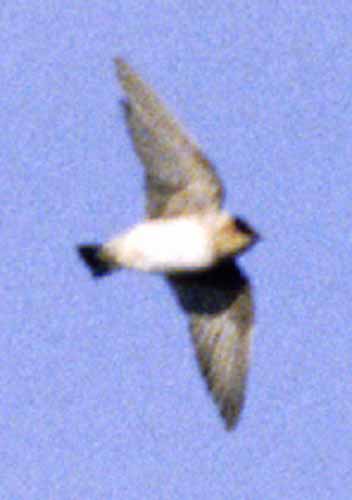 
Figure 7.
Undersurface view. The underwing coverts and axillaries are
sandy-brown. The flanks appear to be white with no more than
a slight buff wash along the very base of the wing.
|
|
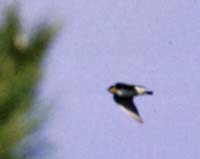 
Figure 8. Distant view
as the bird dips behined a stand of pines marking the perimeter
of the golf course.
|
|
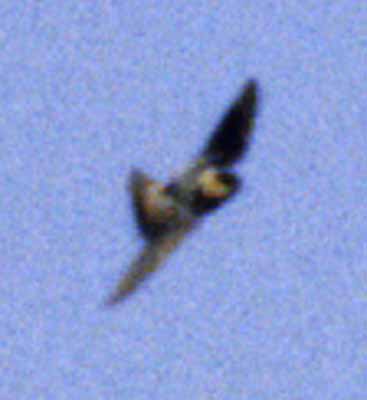
Figure 9.
A view of the uppersurface as the bird banks sharply. The
pale nape separating the dark back from the dark cap is quite
obvious in this shot as well as the pale brick colored rump
patch . Although out-of-focus, the series of pale stripes
running lengthwise across the dark blue mantle are visible.
|
Click here for a second page of photos.
Click here for a description of the
sighting.
Return
to Gallery Index
Cave Swallows (Petrochelidon
fulva)
Riis Park/Fort Tilden, Queens, New York
Saturday 11/28/98
Angus Wilson and Andy Guthrie
Events: As part of our regular
circuit covering Jamaica Bay Wildlife Refuge, Riis Park/Fort Tilden
and Floyd Bennett Field, we stopped to check a traditionally productive
area of scrub separating the Riis Public Golf Course and beach
front. As we walked along the perimeter fence, through some disused
handball courts, we noticed a small hirundine flitting along the
southwestern edge of the golf course. Through binoculars we could
see that the bird had a dull brick-red rump, pale underparts and
a pale throat offset by a weak reddish breast band. We knew immediately
that we were looking at a Cave Swallow. We quickly returned to
the main Riis parking lot to collect our camera gear and returned
to the spot. The time was now 9:25 am. We soon relocated the bird
as it coursed over the small stands of pines dotted around the
center of the golf course. Over the next hour we studied the bird,
taking notes and a number of photographs. The bird tended to keep
within the boundary of the golf course itself and only occasionally
came very close to us, once or twice passing directly overhead.
We were able to watch the bird through telescopes and binoculars.
Attempts to video the bird proved too difficult given the distance
and limited field of view.
At about 10:30 we spotted two swallows circling above the fire
station and horse stables, at least one of which was a Cave Swallow.
We initially presumed (by default) that the second bird must have
been a Tree Swallow (Tachycineta bicolor). Both birds vanished
from sight. After a further 15 minutes without relocating the birds,
we headed for the Park Headquarters building and ran into Dorothy
Poole and Gaye Fugate. They informed us that a Cave Swallow had
been written in the log book from the day before by Isaac Grant
and Gene Herskovics. Like us, Poole and Fugate had not otherwise
been aware of this previous sighting. From a pay-phone outside
of the headquarters, AG made a series of calls to local birders
most of whom had traveled upstate or to Massachusetts for the holiday
weekend. In the course of making these many calls, he spotted two
swallows circling over the large grassy areas at the entrance to
the park near Building 149 and the vegetable lot. Remarkably, both birds
were Cave Swallows. During the next twenty minutes we saw these
two birds several times. They were rarely close together and I
was unable to obtain a picture of both birds in the same frame.
The very mobile behavior and the wide-separation of the two congeners
suggested a very diffuse prey base. We speculated that it paid
for the two birds to stay well apart to minimize competition. John
Bull and party pulled up as we were about to leave. We alerted
them to the our exciting finds which were still circling very high
overhead. We left at about 11:30 am but have been informed that
other observers, including Nellie Larsen, Max Larsen and Robert
Kurtz, saw the birds during the afternoon.
Description: (Adapted from
field notes taken whilst watching the initial bird. During our
later observations of two birds together such close inspection
was not possible however both appeared extremely similar to each
other (plumage details and wear) as well as to the bird studied
over the golf course. This description was prepared prior to any
consultation with reference material or our photographs).
A small, neat and short-tailed hirundine. Plumage appeared relatively
fresh. All the flight feathers appeared intact and in good order.
Weak buffy-orange wash across the upperbreast; this band was not
sharply defined (as in Bank Swallow) but appeared as a diffuse
wash, becoming slightly paler on the throat. The pale throat contrasted
with a dark facial mask and cap. This sharp separation was very
apparent, even at considerable distance. When seen from below,
the white or perhaps pale buff underparts (lower breast, vent,
belly and flanks) contrasted sharply with darker (sandy-brown)
underwings. Tail almost square perhaps with very slight fork. Rump
patch a pale brick-red (similar to palest bricks used in nearby
concession building), contrasting with darker rectrices. The rump
seemed less obvious than on a typical Cliff Swallow and we speculated
that this might be due to a lighter brown tone to the uppersurface
of the wings. Mantle and scapulars dark metallic-blue with several
parallel white stripes visible only at close distance. Clearly
defined pale collar separating the dark crown from the dark mantle.
A dark mask extended from the base of the bill, across the lores
and eye to the crown. Despite repeated efforts, we were unable
to firmly attribute a specific color to the dark forehead, oscillating
between dark red and the same dark blue as the cap. The key point
however is that the forehead was not obviously white.
Ranged from 25 feet off the ground to more than 500 ft. Often
working into the wind. Although we saw no Tree Swallows during
the day, the flight style seemed relatively slow and steady without
the dramatic dips of other species. On several occasions, this
feature resulted in momentary confusion with Starlings (Sturnus
vulgaris), which were abundant on the golf course. Neither
bird heard to call at anytime even when together. Both of us (AG
and AW) have prior experience of Cave Swallow (breeding birds in
Texas) as well as several other hirundines. AW also has experience
with Red-rumped Swallow (a remote possibility?).
The steady west winds raised the hope that the birds would remain
in the area and many birders converged on Riis Park and Fort Tilden
the following morning (11/29/98). However, in spite of exhaustive
searching throughout the day, neither bird was seen again.
Analysis of photographs: (in progress.)
Discussion: Once an extreme
vagrant to northeastern North America, Cave Swallow has become
an annual late fall occurrence at Cape May Point, NJ (Mlodinow
and O'Brien, 1996). There are records from the last seven seasons
with a maximum of five there between the 7th and 16th November
1997 (Paxton et al., 1998). This species was recorded several times
from Cape May this fall season, with two birds over the Cape May
National Golf Course on November 23rd 1998 (Cape May RBA). Given
the similarity in timing, we speculate that the same mechanism
is responsible for these now regular New Jersey occurrences and
the two Riis Park birds. It is even possible that the same individuals
are involved. There is only one previous record of Cave Swallow
from New York State, a one-day bird observed at Jamaica Bay Wildlife
Refuge on 23 May 1990 (Levine, 1998).
There are at least five races of Cave Swallow - nominate fulva of
the Caribbean; pelodroma breeding in northern Arizona, southeastern
New Mexico, Texas and northern Mexico; citata of the Yucatan
Peninsula and two races restricted to South America (chapmani and rufcollaris)
(Turner and Rose, 1989; Howell and Webb, 1995). The rump (uppertail-coverts)
of both fulva and citata are described as cinnamon-rufous
or chestnut and we believe, would appear significantly darker than
either of the Riis Park birds. The undertail coverts of fulva are
also reportedly darker than pelodroma. Although we did not
note significantly dark undertail coverts, this feature seems too
subjective without direct comparison to be of much use. On the
basis of the rump color and lack of an orange wash to the flanks,
we would argue that these individuals correspond to the race pelodroma.
This conclusion must be regarded as very preliminary pending further
research. The prior New York record was attributed to the Caribbean
subspecies fulva (Levine, 1998).
Literature Cited:
Howell, S.N.G. and Webb, S. (1995) A Guide to the Birds of Mexico
and Northern Central America. Oxford University Press.
Levine E. (ed.) Bull's Birds of New York State. Cornell University
Press.
Mlodinow, S.G. and O'Brien, M. (1996) America's 100 Most Wanted
Birds. Falcon Press.
Paxton, R. O., Boyle, W. J., and Cutler, D.A. (1998) Regional
Reports: Hudson-Delaware region. Field Notes 52(1): p37.
Turner, A. and Rose, C. (1989) Swallows and Martins. Houghton
Mifflin Co.
Click here for some additional pictures.
Click
here for a collection of comments on the photos and discussion
of subspecific identification and ageing by subscribers to ID-Frontiers.
Return
to Gallery Index
|

